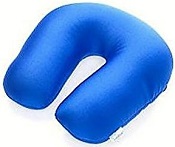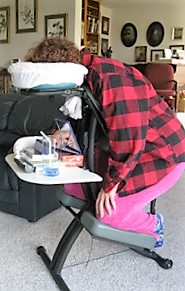Macular Hole Surgery Recovery Techniques and Suggestions from Readers
 Joy R. Efron, Ed.D.
Joy R. Efron, Ed.D.
In Surviving Recovery from Macular Hole Surgery, I discussed Factors Contributing to a Successful Outcome After Macular Hole Surgery and Suggestions for Maintaining Face-Down Positioning After Macular Hole Surgery. Since then, I have been contacted by dozens of people worldwide who have provided their own helpful suggestions for successful face-down positioning and recovery.
Remember that vision recovery is your goal throughout this process. You must stay face-down as long as your doctor instructs. Face to the side is not face-down. If your head is to the side, the pressure of the gas bubble is not being exerted at the spot where your macular hole is located.
Before you implement any of these suggestions, it’s important to check with your own doctor if you have any additional medical or physical issues, such as cardiac problems or spinal degeneration.
Reader Feedback and Suggestions
Massage
Massage was a universal recommendation from readers. If you cannot afford a professional massage, ask every visitor to help massage your neck and back muscles.
Physical Therapist
It is important to consult with a physical therapist. Face-down positioning results in your shoulders being pushed forward. This pulls the scapular muscles forward and causes spasm and pain in your back and shoulder muscles. This, in turn, also causes neck pain.
Try avoiding this by “opening up” your shoulders several times a day. Stand while maintaining face-down positioning. Start with your arms down at your side. Bring your arms backward with your palms facing each other. Squeeze the lower shoulder blade area toward the center of your spine.
Vitrectomy Equipment vs. Massage Equipment
Many people contacted me saying that they could not find vitrectomy equipment. In fact, the equipment I discuss and recommend is actually massage equipment. Several people who wrote to me said they bought or rented their equipment through a massage supply store or directly from a massage therapist. Not everyone has access to a company that sells or rents vitrectomy equipment.
More Suggestions from Readers
Pillows and Towels Can Be Very Helpful
- “I did use pillows under my armpits while lying on the Ergo face-down Lounger.”
- “I piled up pillows on the tray under the face cradle so I could rest my arms there while sleeping.”
- “Face towels rolled up under each armpit/shoulder helped a lot on the Ergo lounger and on the bed.”
- “A couple of pillows on a massage table were almost the same as the arched platform.”
- “The downward pressure and the resulting ‘back pressure’ on my face created some pain. Removing some of the rather stiff cushions and wrapping towels around the face-holding apparatus helped some of the time.”
Use a “Sqush” Pillow
- “Even with the face cradle and a smooth, soft cloth, it started to feel rough on my face. See if you can buy a soft neck pillow (pictured below, usually used for airline travel). I think they are filled with polyurethane beads. I turned it around (opposite of the way you’d use it for your neck) and placed it atop the face cradle.”

A “Sqush” neck pillow
- “Use the soft ‘Sqush’ neck pillow atop the face cradle to soften the feel of the fabric on the face. Even with the fleece cover, the face-down positioning was very uncomfortable on my skin while trying to sleep. The soft ‘Sqush’ pillow solved that problem.” (pictured below)

A “Sqush” neck pillow atop the face
cradle to help with sleep
Change Positions Frequently
- “My physical therapist urged me to change positions in small ways a lot. He also insisted that I put pillows under my hips and I came out with no aches or pains.”
- Also see Suggested Resources for more information about helpful products.
Activity and Exercise
- “I could somewhat comfortably use my small portable DVD/TV player with the massage chair.”
- “I’m using a Kindle to use the Internet and download audio books and email. It’s small enough to fit on a table under my face support device.” (An iPad or tablet is also effective.)
- “Getting down on hands and knees with my rear up, rocking, as well as crawling, eased my neck and shoulder pressure.”
- “I put a facial tissue under my chin as I walked around. If it fell out, I knew my head was not face-down sufficiently.”
- Also, you can ask the physical therapist if there are stretching exercises you can do for the shoulders and neck while remaining face-down.
Face Positioning, Pain Relief, and Safety
- “I used a two-way mirror with a dishcloth folded under my chin to move around during that time. If the dish towel fell, it alerted me that I was not face down.”
- “I used the massage chair almost all the time. I discovered that my neck could rest a little when I had my forehead resting on the head cradle of the chair.”
- “The most helpful thing to help me stay face down was the Ergo lounger! I spent most of the first two days and nights on the Ergo.”
- “I reasoned that gravity would cause the majority of macular tissue to accumulate in the ‘bottom’ of the eye, so I tried to look towards my feet even when face down since this would put the bottom of the eye in a ‘top,’ upward position and gravity would then help to push it into the correct position. This ‘over shifting’ gave excellent results, according to my doctor.”
 Joy using face-down
Joy using face-down
equipment to keep
necessary items within
reach
- If you have an adjustable high typing/computer/dictionary table or adjustable tripod, set the table surface at chest level in order to rest your head, eat, drink and even use the computer (for short periods of time) while standing and maintaining face-down positioning.
- “I used a ‘corn bag’ (a fabric bag filled with corn) that gets heated in the microwave and then placed on my neck.”
- “A hot bath first thing each morning, instead of a shower, felt great on my sore lower back.”
- “Make sure that cupboard doors are closed so you don’t walk into them with your head down.”
- Try a variety of over-the-counter creams and lotions, such as Mobisyl, Arnica, Bio-Freeze, ThermaCare (topical relief for pain and muscle stiffness) and Eucasol (congestion relief).
- Also, be sure to check with your doctor about over-the-counter and prescription medications that can help with pain and muscle stiffness.
- Use bright nail polish to mark your desired levels on your coffee pot and water reservoir.
You can learn more about these techniques and equipment at Suggestions for Maintaining Face-Down Positioning After Macular Hole Surgery and Suggested Resources for More Information on Macular Hole Surgery.
As Your Vision Improves
- Close your “bad eye” if the different visual images you receive from each eye are disturbing.
- Prior to cataract surgery, remove the lens of your old glasses for the operated eye if it is difficult to see either with or without glasses because the two eyes can’t coordinate. (The brain doesn’t like double images.)
- Limit close visual tasks to 15-20 minutes. Then get up and take a quick walk or do something requiring distance vision. Close visual work for more than a few minutes at a time with a macular hole is very tiring and exhausting as well as not being efficient.
- Use good contrast and effective lighting throughout your home.
Also see Suggested Resources for more information about helpful products and organizations, as well as the author’s contact information.
A Disclaimer
I was an educator of blind and visually impaired children for 42 years. Although I have read and researched a great deal and have had extensive discussions with retinal specialists, I am not an ophthalmologist or a medical doctor.
Reviewed by Mrinali Patel Gupta, M.D., VisionAware Medical Consultant. Reviewed by author August, 2023.